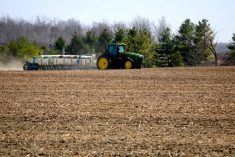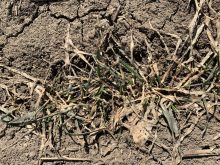Wheat needs heat. With few truly warm days seen so far — as well as unfavourable planting conditions in the autumn of 2018 — agronomy experts say to not rush in condemning your winter wheat.
“We had an estimated 900,000 acres of wheat planted last fall; 89 per cent was soft red, seven per cent was hard red, and four per cent was soft white,” says Joanna Follings, cereal specialist with the Ontario Ministry of Agriculture, Food and Rural Affairs.
But much of that crop, she says, was not planted until mid- to late-October as a result of inclement weather. Much of that was also planted in conditions colder and wetter than ideal, which could lead to survivability issues. Follings says this is particularly true for farmers who previously planted long-season soybeans, and a primary reason why many areas saw little pre-winter emergence.
Read Also

Senft to step down as CEO of Seeds Canada
Barry Senft, the founding CEO of the five-year-old Seeds Canada organization is stepping down as of January 2026.
Why it matters: Poor planting conditions and some winter freeze-thaw cycles have farmers worried for the Ontario winter wheat crop.
Deb Campbell, an agronomist with Agronomy Advantage, believes about one-third of the wheat acres in her area were planted late. With little emergence, accurately predicting overwintering success is a challenge. She says “a good solid mild spell” is required to know just how good or bad a given field is.
Winter conditions mixed
In the province overall, Follings says winter ice cover was not a huge problem. Naturally insulating snow was also fairly consistent. However, a particularly concerning melt-freeze episode in February might have hurt some fields. For this reason, she encourages growers who had to plant in poor conditions, or didn’t plant on time, to check fields that had ice cover first.
For Campbell, issues with lying water this spring have caused some concern, but have not been particularly significant.
“It’s really, in my opinion, planting date, and a pool fall season to to get planting wheat and for it to develop,” she says. “It’s just unfortunate there is a significant portion of acres in that time frame.”
According to Ryan Benjamins, an agronomist and owner of Benjamins Agronomy Services in Plympton-Wyoming, there is greater survivability concern for those working with heavier, water-retaining clay soils. He also reiterates the freeze-thaw cycle — otherwise detrimental to winter wheat — was not a unique problem.
However, Benjamins has noticed some fields “giving up” just in the last couple weeks. Colder spring conditions have further confounded the ability of individuals to determine what is dead, and what is not. This applies even more to those analyzing fields with both green and brown patches.
“There are warmer temperatures in the forecast. We don’t need to be making that decision today,” he says.
Both Follings and Campbell agree. As of the end of March, says Follings, only about half of the 80 to 100 degree-days required for post-winter growth have been achieved.
Immediate practical steps
In the meantime, Follings says growers can try and perform stand counts in potentially problematic fields. They can also check seedling vitality by collect seedlings with crowns, trimming stems to one inch above those crowns, placing them in a plastic bag and rinsing with water every couple days; if no new crown growth appears, the seedling has died.
Regardless, all three experts say dead spots within a field are, at this point, not necessarily indicative of the area as a whole.
“I’d definitely give it some time. Patience is key, says Follings. “I would encourage growers to wait as long as possible to see how things go.”
Benjamins adds those going into corn might be able to get ahead of things by applying nitrogen and sulphur in the interim.
“Just stay in touch with your seed dealers so you can still get the seed you want if you need it,” he says.















